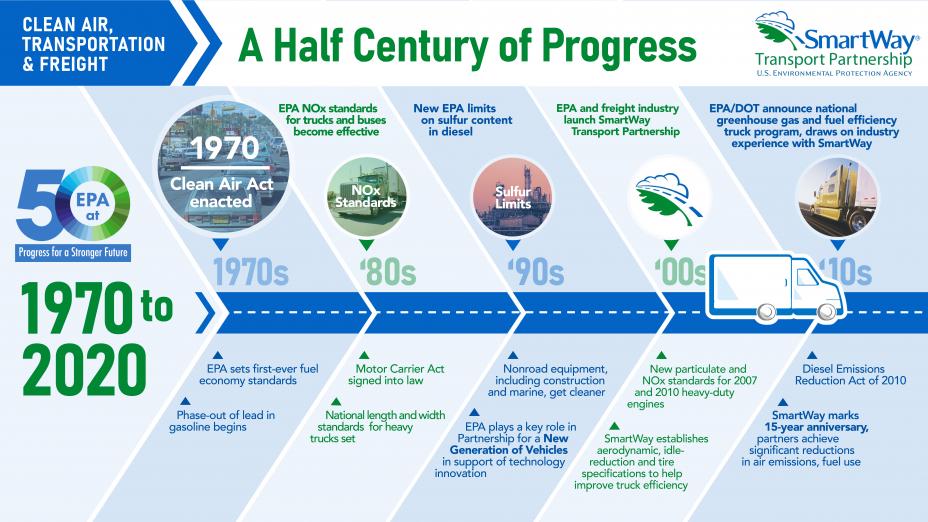SmartWay Timeline
 50 Years of Efficiency Advancements in Transportation and Freight
50 Years of Efficiency Advancements in Transportation and Freight
On EPA’s 50th anniversary, the SmartWay program looks back at the progress the transportation and freight sectors have made to reduce emissions – and keep the economy rolling. Since the enactment of the 1970 Clean Air Act, virtually all vehicles manufactured today, including cars, pickup trucks, heavy-duty trucks and buses, are roughly 99 percent cleaner, while Gross Domestic Product continued to grow.
Through its regulatory programs and SmartWay, EPA expects that the efficiency and environmental performance of trucks and the entire freight industry will continue to advance well into the coming decade. For now, here’s a look at how far we’ve come!
When EPA was created, its focus in the early 1970s was to reduce emissions from passenger vehicles, which represented the majority of vehicles on the road - just as they do today. EPA acted swiftly to reduce pollution from automobiles, setting emissions standards that led to the introduction of the catalytic converter and initiating the phase-out of leaded gasoline.
Standards to curb emissions from medium and heavy-duty trucks, which are mostly powered by diesel fuel, also have been key to achieving major air quality improvements. NOx standards for trucks and buses were set in the early 1980s, followed in 1990 by strict limits on the sulfur content in diesel, resulting in significant environmental and public health benefits.
Throughout the 2000s, trucks got even cleaner and more fuel-efficient. New, stringent particulate matter and NOx standards were issued for heavy-duty engines, effective in 2007. EPA launched SmartWay, a public-private partnership with trucking companies and shippers that share a goal to cut fuel use and improve freight sustainability. EPA and DOT collaborated on a series of comprehensive greenhouse gas and fuel efficiency standards for heavy-duty trucks.
As EPA looks ahead, in the U.S., and globally, transportation is a growing and large source of carbon emissions - and the rate of growth in emissions from freight-related activities is outpacing the rate of growth from cars. Carbon emissions are a major contributor to climate change.
In the future, the Agency will continue its partnership with the transportation industry to reduce carbon and other emissions harmful to the environment and human health. We anticipate that significant advancements in electric truck technologies, vehicle connectivity and logistics automation will transform the freight industry as we know it today, making it cleaner, more efficient and resilient.



